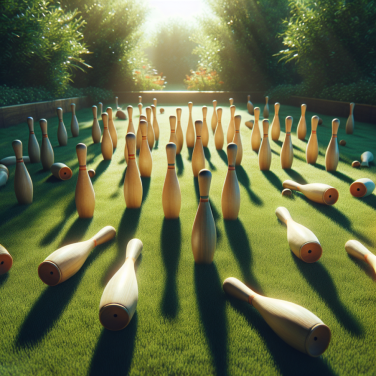The Rise and Fall of Lawn Darts, often referred to as Jarts, began as an innocuous backyard game enjoyed by families across North America. The game consisted of large darts with metal or plastic tips and fins, designed to be thrown underhand towards a target circle on the ground, similar to horseshoes. It rose to popularity in the 1960s and 1970s due to its simplicity and the joy of engaging in friendly competition during summer gatherings.
However, the very design that made lawn darts thrilling was also what made them dangerous. The heavy metal tips could cause serious injury or even death if they struck someone. Although initially these incidents seemed rare, reports of injuries began to accumulate, highlighting the potential for tragedy when the darts were misused or when children were able to get their hands on them unsupervised.
By the 1980s, the Consumer Product Safety Commission (CPSC) in the United States had documented numerous injuries attributed to lawn darts. Many of these injuries involved children, and some were quite severe, including instances of blunt force trauma and penetration injuries. What had started as a leisurely activity was now becoming recognized as a significant safety hazard.
The game's fall from grace began as activists, led by parents of injured children, started to petition for a ban on lawn darts. Their advocacy drew attention to the disproportionate risk the game posed relative to its recreational value. Though initially, there were attempts to regulate the sale of lawn darts - such as labeling them as unsuitable for children or restricting their purchase - these measures were not considered sufficient to protect consumers.
The tipping point came when several highly publicized accidents occurred, including fatalities. These tragic events catalyzed public opinion against lawn darts, and by 1988, the CPSC issued a ban on all sales of the product in the United States. It became illegal to sell, offer for sale, import, or distribute lawn darts, effectively leading to their disappearance from backyards and store shelves.
Despite the ban, some enthusiasts have continued to play with pre-ban lawn darts or make modifications to existing sets to sidestep regulations. However, these activities remain controversial and are not recommended due to the inherent dangers the game poses.
This history of lawn darts serves as a sobering tale of how a simple pastime can become a public safety issue.
Tracing the Origins: How Lawn Darts Became a Popular Outdoor Activity
Lawn darts, also known as Jarts, captured the hearts of families looking for backyard fun with their inception in the mid-20th century. But where did this once-popular game come from, and how did it find its way into the backyards of millions?
The origins of lawn darts can be traced back to the ancient world, with similar concepts found in various cultures. In medieval Europe, for instance, a game known as jeu de fers, which involved tossing metal projectiles at a target, was common. In many ways, these early throwing games provided the conceptual foundation for what would eventually become lawn darts.
As modern history unfurled, the development of lawn darts as we recognize them began in earnest. In the 1950s, lawn darts began gaining popularity as a garden game in the United States. Originally designed with heavy metal tips to weight the darts, they were intended to be thrown in an arc toward a target, typically a hula hoop or a similar ring laid flat on the grass.
This newfound leisure activity appeared during an era when the American middle class was booming post-World War II, and the suburban sprawl gave families ample yard space to enjoy such games. Manufacturers and marketers capitalized on this trend, promoting lawn darts as essential components of family fun, alongside other outdoor activities such as barbecues and pool parties.
The appeal of lawn darts was multi-generational. The simplicity of the game made it easy for all family members to understand and participate, from young children to grandparents. It required little initial investment and minimal setup time, leading it to become a staple at family gatherings, camping trips, and picnics. The allure of competition, combined with the outdoors and physical activity, made lawn darts a go-to form of entertainment throughout the 1960s and 1970s.
Despite its popularity, the inherent danger of the weighted metal tips did not go unnoticed. By the mid-1970s, the Consumer Product Safety Commission (CPSC) began to express concern, as reports of injuries started to emerge. The perilous aspect of lawn darts became more pronounced when matched with the unpredictable nature of throws by children or the influence of alcohol at adult parties, leading to accidents that were sometimes severe or even fatal.
Following a series of injuries and resulting legal actions, the CPSC banned the sale of lawn darts in the United States in 1988.
From Recreational Fun to Banned Hazard: The Controversial Downfall of Lawn Darts
Lawn darts, or Jarts as they were once popularly known, seemed to encapsulate the epitome of leisurely backyard amusement. Originating in the mid-20th century, these games provided a simple yet engaging pastime for families and friends. Participants would take turns tossing the weighted darts underhand toward a target ring laid out across the lawn, combining elements of skill, competition, and outdoor enjoyment.
Initially, lawn darts were met with positive reception and quickly became a staple in suburban backyards. Their popularity soared as they were marketed as an enjoyable game for all ages, easily set up for picnics, barbecues, and casual gatherings. They offered a new dimension to outdoor entertainment, blending the appeal of horseshoes and bocce with a unique aerial twist. The simplicity of the game and the minimal setup required contributed to their widespread acceptance and integration into recreational activities.
However, the darker aspect of lawn darts emerged as a growing concern. The pointed, metal-tipped projectiles, although designed for jovial play, posed a significant danger. Owing to their weight and sharpness, when thrown improperly or carelessly, they had the potential to cause serious injury. Reports of accidents began to trickle in, with some leading to severe consequences, including emergency room visits. Most distressing were the incidents involving children, who were often the unintended victims of misguided throws.
Campaigns for the regulation of lawn darts soon gained momentum as the number of injuries escalated. Perhaps the most impactful was the campaign led by David Snow, who tragically lost his daughter to a lawn dart accident in the mid-1980s. Snow's advocacy, coupled with the accumulation of injury reports, drew the attention of consumer safety groups and eventually the government. The Consumer Product Safety Commission (CPSC), which was initially hesitant to impose a complete ban, was driven to stricter measures after realising the inadequacy of prior warnings and packaging alterations meant to mitigate risks.
In 1988, the CPSC issued an outright ban on lawn darts in the United States. The ban was a significant turn of events, one that marked a swift downfall from the game's prior popularity. It was no longer legal to sell or distribute the game as it was known, and warnings were issued to consumers to dispose of any lawn darts they owned to prevent further accidents.




